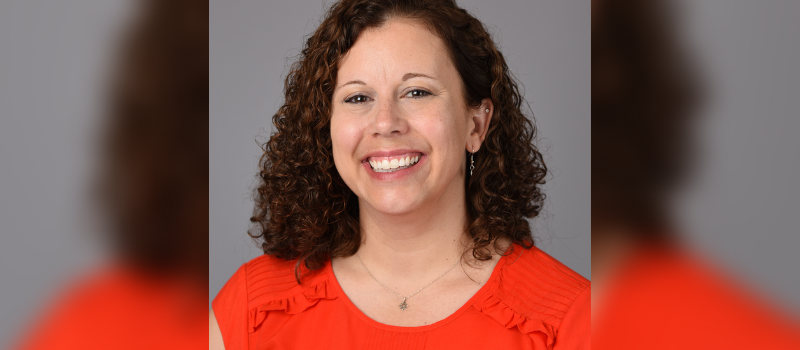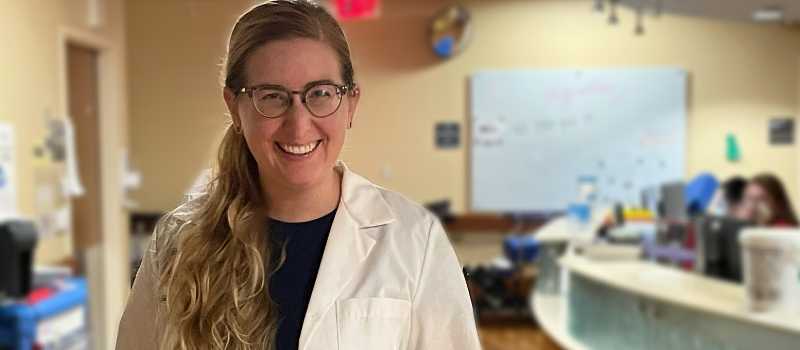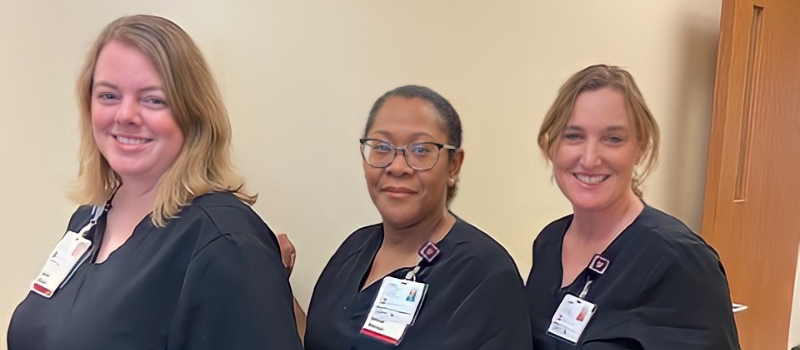September is Sickle Cell Awareness Month and the IU Health West Emergency department is working to expand both clinical care and education to combat the disease.
By Charlotte Stefanski, marketing associate, cstefanski@iuhealth.org
September is National Sickle Cell Awareness Month—a blood disorder that impacts about 100,000 Americans.
As IU Health West Hospital has continued to treat patients with sickle cell disease—and has also seen an increase in patients seeking care for it—the emergency department is looking to expand its care offerings and educate team members.
What is sickle cell disease?
While sickle cell disease impacts thousands here in the United States, not much is known about the disease—which has limited treatment options and no cure.
So, what is sickle cell?
“Sickle cell disease is a genetic disease that affects how red blood cells are shaped as they travel through the blood vessels of the body,” said Dr. Karen Crevier, medical director of West’s Emergency department (ED). “This causes complications related to how well the red blood cells can carry oxygen; as well as issues with blood clots, like strokes and pulmonary emboli.”
The most common issue though—and what typically sends those with sickle cell to the ED—is pain crises. During a crisis, red blood cells make microscopic clots in the bones and can cause severe pain, Dr. Crevier explains.

While anyone can have sickle cell, the disease primarily impacts Black and African American populations. According to the Centers for Disease Control and Prevention (CDC), it occurs in about one in 365 Black or African American births and one in every 16,300 Hispanic American births.
A noticeable increase
As the west side of Indianapolis has experienced rapid growth in the last few years, providers and team members working in the ED have noticed an increase in patients with sickle cell.
Leslie Gibbs, the head advanced practice provider of the emergency room and observation unit at West, said there are plenty of reasons for the increase.
Along with the population growth, Gibbs adds that there’s a critical need for treatment options for those with the disease, especially on the west side of Indianapolis. While pediatric patients with sickle cell can receive robust treatment options with Riley Children’s Health specialists, they’re now looking for adult services as they age out of pediatric care.
“Because of all that, we’ve really identified our population with sickle cell as being one that needs more attention and a more structured approach,” Gibbs said.
When patients with sickle cell come to the ED, they’re typically seeking pain management for a crisis. The first thing team members work on is getting their pain under control, Gibbs said.
But the disease also has other serious consequences that can impact the heart, lungs and more. Patients may experience mini strokes in the brain or kidney infarction. So, as patients come in to treat pain, Gibbs and her team also run blood work or take x-rays to ensure there isn’t something more serious.
“These are patients—that often from birth—have extreme pain and microvascular damage in many parts of their body that we don’t even fully understand yet, because it’s not a very well researched disease,” Gibbs said.

Expanding services and education
Due to the complications surrounding sickle cell disease, IU Health West is looking to standardize the care of patients with sickle cell in the ED and the department’s observation unit.
Both Crevier and Gibbs said treating sickle cell in the ED can be a long and stressful process, for both patients and team members. Managing a pain crisis can be difficult to do in a short ED visit, but patients typically want to avoid being admitted to the hospital or transferred downtown, as that requires an extended stay.
“We are working on processes to get pain better controlled earlier on in the ED stay and facilitate better communication with the outpatient physicians that are managing these patients to hopefully decrease the need for emergent care,” Crevier said.
That’s where West’s six-room observation unit comes in handy. Since it opened three years ago, the unit has served as a comfortable, quiet and short-stay place for those experiencing a pain crisis as team members work on a plan for treatment.
The unit has seen success with that process in the last few years, and now, the ED team looks to develop it into the home for patients with sickle cell.
“When a patient comes into the ED experiencing a pain crisis due to sickle cell, they’ll be worked up to make sure none of those other scary things are happening, but they’re also going to be moved pretty quickly into our observation space,” Gibbs said. “That way, we can give them more time and a more aggressive treatment to help get on top of their pain.”
These patients will also have access to other types of care and services that aren’t in the ED. They’ll be connected with a social worker, who can speak with them about barriers to care, what their resources are like, and also connect them to community groups that can assist in different ways.
West is also trialing a new telehealth component that will connect patients to resources downtown via an iPad.
“This will help get these patients plugged in and get them what they need to manage these crises better, and hopefully prevent the crises from having in the first place,” Gibbs said. “They don’t have to keep interrupting their lives to come into the hospital.”
As patients with sickle cell come to the ED, team members are also looking for easier ways for them to manage their pain. The process can include a fair amount of medication, Gibbs explained, and she’s looking to implement a medication delivery system that the patient can control.
The patient would simply push a button when in severe pain, and a small dose of IV pain medicine would be distributed. This would help patients receive relief during their stay a lot more frequently, which can be a big help for team members if the unit is short-staffed.
Currently, nurses are being trained on the equipment, and along with the telehealth aspect, Gibbs hopes to see both running in the next few months. In the future, she hopes the observation unit can expand to eight beds to accommodate more patients.
The psychosocial impact
Along with the physical side of sickle cell—a painful and chronic disease—there are plenty of psychosocial impacts, including poverty, food insecurity, barriers to healthcare and education, less than ideal housing and more.
“There’s a lot of challenges that are really heaped on top of these patients that are already dealing with a terrible disease,” Gibbs said.
As a social worker stationed in West’s emergency department, Leslie Sheeler’s days are often unpredictable. She could be helping a patient find a primary care doctor, a prescription at a lower price or assisted living. She’s also seen plenty of abuse cases too.
When she first started at West nine years ago, Sheeler didn’t have any patients with sickle cell, but around 2018, that changed. And once COVID-19 became manageable, Dr. Crevier reached out to Sheeler as the ED began its plan to expand sickle cell care.
“I was going to try to help more of their psychosocial issues; Are they seeing their doctor? Are they taking their medication? Are they having issues with transportation or work or food pantries—whatever the case may be,” Sheeler explained.
However, Sheeler admits she didn’t know much about the disease. She reached out to the Martin Center, which has been a resource for sickle cell in the community for more than 40 years. It heavily focuses on education, working with medical professionals, caregivers and more.
Since meeting with the organization, Sheeler has tried different ways to help educate her fellow team members, including bringing the Martin Center to West every Thursday this September. She’s also spoken with team members one-on-one, posted flyers in breakrooms and restrooms and shared links to informational sites.
“We have a wide range of people and roles working in the ED and everybody learns differently,” Sheeler said.

Sheeler, Gibbs and Crevier all agree that education on sickle cell disease is crucial for team members, as it helps break stereotypes and stigma surrounding it.
When any patient comes into any emergency department seeking pain treatment, there can often be an implicit bias—an unconscious association, belief, or attitude toward any social group. Further education on sickle cell disease can help prevent this line of thinking and create better patient outcomes.
“Anytime there is a shift in healthcare practice, education is needed,” Gibbs said. “We are working hard to support our team’s growth in knowledge and skills to better support the complex medical and psychosocial needs of a population that has faced historic racism and underfunded research.”
Sheeler adds that the disease impacts every aspect of life; if someone with sickle cell is in pain, they can’t go to work. If they can’t go to work, they can’t pay their bills, buy food or put gas in their car. If they don’t have gas, they can’t get to the hospital. And if they manage to get to the hospital, that can take time away from work or require childcare.
“I would really like for patients to feel comfortable when they come to us, to know that our staff is aware of sickle cell disease and that they know medically how to help them. We’re sensitive to the stress that they’re going through in their everyday life,” Sheeler said. “I want them to feel like they can come here and ask for help, get what they need and feel supported.”
Keeping up with new resources
While medication is used to mitigate the symptoms of sickle cell disease, Dr. Crevier adds that a multidisciplinary approach to the disease is essential.
Connecting patients to sickle cell education and other community resources only helps their outcome.
“When managed well, these patients can live fulfilling lives, but this takes a multidisciplinary approach; patients need to have good follow-up care and ways to get to their appointments,” Dr. Crevier said. “Whatever we can do to decrease barriers to these resources will help improve their lives.”
